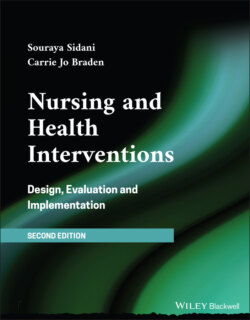Читать книгу Nursing and Health Interventions - Souraya Sidani - Страница 88
Methods
ОглавлениеThe first step of the strategy focuses on eliciting the target population's conceptualization of the health problem. It uses a mix of quantitative and qualitative methods to obtain relevant data in group sessions.
Prior to the group session, the researchers generate a list of indicators and determinants of the health problem, from a review of pertinent theories, empirical studies, and practice sources (e.g. consultation with health professionals). The researchers prepare a brief description, in lay terms, of each indicator and determinant. The descriptions are incorporated in a questionnaire to assess their relevance and/or importance to the target client population. The questionnaire contains the following for each indicator and determinant: its name (e.g. difficulty falling asleep), its description (e.g. it takes 30 minutes or more to fall asleep), and a rating scale (e.g. numeric rating scale anchored with not at all—0 and very much—10) to determine its relevance (i.e. extent to which it is experienced by members of the target population) and importance in contributing to the experience of the health problem. In addition, researchers prepare a set of open‐ended questions to engage the group in a discussion to elaborate on the population's perspective on the problem and identify other relevant indicators and determinants of the problem.
During the group session, the researchers:
1 Explain the purpose of the session, which is to get an understanding of the client population's view and experience of the health problem.
2 Give an overview of the health problem by describing what it is.
3 Distribute the questionnaire and provide instructions on how to rate the indicators and determinants; that is, their relevance and importance to the population.
4 For each indicator and determinant, read its name and description; clarify any misunderstanding; and invite participants to complete the rating, individually, by selecting the most appropriate response option.
5 Once all indicators and determinants are rated, engage participants in a discussion to further elaborate on the conceptualization of the problem. Guiding questions include: (1) Which indicators are commonly reported when people experience the health problem? Are there other indicators? Which indicators are most important and could be managed to help resolve the problem? (2) Which determinants significantly contribute to or cause the health problem? How do these determinants lead or cause the problem? Are there other determinants? Which determinants should be addressed to help resolve the problem? Which should be given priority? What makes them important? (3) Are the indicators and determinants important for all people or are some more or less important for particular groups of people (e.g. men/women, young/older)?
After all group sessions are completed, the quantitative ratings are analyzed descriptively to determine the most relevant and important indicators and determinants (indicated by high means and low variances). The transcripts of the qualitative comments are content analyzed. A matrix is used to integrate quantitative and qualitative findings and identify the most relevant indicator of the health problem, the most important determinants, how the determinants contribute to the problem, and possible differences across subgroups of the target population. The application of this method is illustrated in Sidani et al. (2018b) who found that Chinese Canadians experience insomnia as difficulty initiating sleep, which they attribute to high levels of stress.
